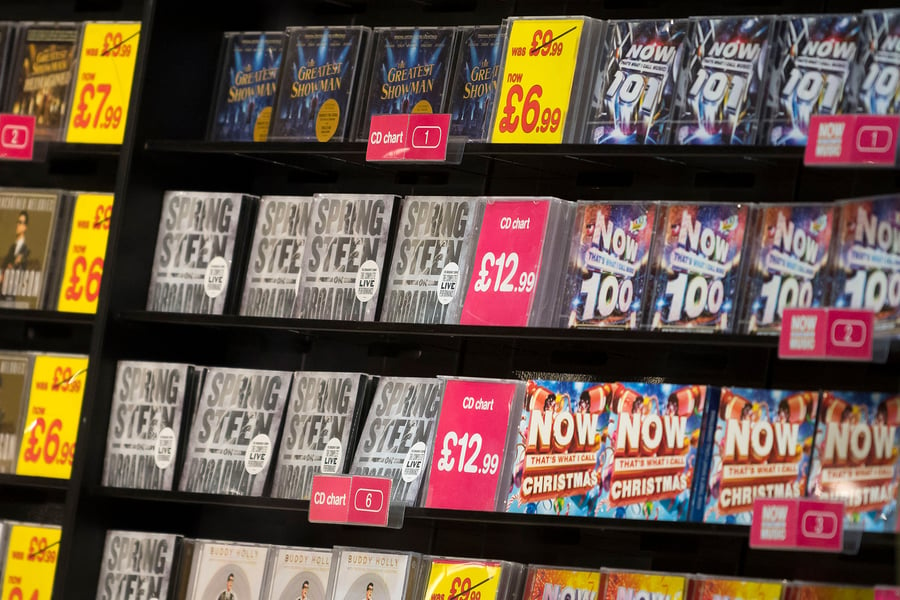If Damian Gandia had to rank his three favorite installments of the Now That’s What I Call Music! franchise, it’d go: Now 10, Now 64, Now 57.
Probably.
With Now 10, it’s mainly a nostalgia thing. Even though the 14-year-old from New Jersey wasn’t born yet when it was released in 2002, the tenth installment of the long-running pop hits compilation — which starts with Britney Spears’ “Overprotected” and ends with Nickelback’s “How You Remind Me” — still brings back memories of music he heard as a kid. With Now 64, which featured Luis Fonsi’s “Despacito” and Billie Eilish’s “Ocean Eyes,” Gandia credits the “top-notch” sequencing: “I don’t even think there’s a single problem with Now 64.” As for Now 57, Gandia says it’s “essential” because of the way it captures what he sees as a moment when pop music was at its peak, featuring Justin Bieber’s “Sorry,” Ariana Grande’s “Focus,” and Selena Gomez’s “Same Old Love” (though there are some notable omissions, he says, like Drake’s “Hotline Bling”).
Now That’s What I Call Music! was started by Virgin Records in the U.K. in 1983; 15 years later, it crossed the Atlantic for an inaugural American edition that included the Spice Girls’ “Say You’ll Be There,” Hanson’s “MMMBop,” and Aqua’s “Barbie Girl.” Throughout the early 2000s, Now regularly topped the U.S. charts.

Decades later, even as album sales have cratered, Now That’s What I Call Music! has held onto a passionate fanbase, albeit a smaller one. Both Now 77, the most recent installment, and Now 73 debuted on the Rolling Stone Top 200 Albums Chart, at Numbers 159 and 104, respectively. And if the RS 200 were based purely on physical sales, Now albums would regularly debut near the top, with as many as 10,000 copies sold in a week even in lean years. In the past five years, only two Now albums have missed the top 10 by sales during their debut weeks.
Fans like Gandia — a self-proclaimed Now critic who posts reviews to YouTube under the name Trevortni Desserped, and an avid collector of Now CDs — offer an eager and earnest answer to the question: “Who listens to Now anymore?” He says that even with endless playlists available on streaming services, Now offers something unique in the way it brings everything together. “As dumb as it sounds, it’s kind of changed my life,” Ganda says. “It provided me with a different format for listening to music. It’s a phenomenon that deserves to be recognized.”
Now chief operating officer Jerry Cohen says the franchise has a “very loyal group of fans,” but it’s hard to sketch a typical member, since the series attracts a wide demographic. There are Gen Z kids like Gandia, people who grew up with the franchise in the late Nineties, and older listeners, too.
“Sometimes it’s a misconception [that] they were very casual consumers that are buying Now because they don’t know what they want to listen to,” Cohen said. “It’s often very, very much the opposite of that.”
Indeed, Gandia is far from a casual consumer. He’s a keen observer of music charts, which he uses to try to predict what the upcoming Now tracklist will be. (He’s pretty good at it, too.) In his review of Now 77, he took issue with what he saw as glaring omissions, like “Do It” by Chloe and Halle, “Franchise” by Travis Scott featuring M.I.A. and Young Thug, and “Lemonade” by Internet Money, featuring Don Toliver, Gunna, and Nav. (He considers the inclusion of 24KGoldn and “Mood” on that compilation “the laziest choice” for a hip-hop song.)
Even so, Gandia admires the sequencing of Now 77 — his favorite aspect of the series overall. “That’s what I find beautiful about it,” he says.
The smooth sequencing choices that Gandia admires so much are something that Jeff Moskow, Now‘s head of A&R and curation since 2000, spends a lot of time laboring over. Moskow likens Now to “musical Switzerland”: The series is “a mirror of popular culture, not a judge of popular culture…. What’s relevant is whether it’s a hit or not.”
In the age of streaming, when there are many ways to define a hit, one of the biggest challenges is blending it all together into one cohesive set. Moskow DJed at clubs when he was younger, and he tries to bring that same feeling, of taking people on a musical journey, to Now.
In particular, he pays a lot of attention to the space between tracks. He will debate with his engineer over a mere quarter of a second, recalling one transition where he was trying to create a “literally seamless blending effect from track to track.”
“We went back and forth for three days,” he says.
From Rolling Stone US






































